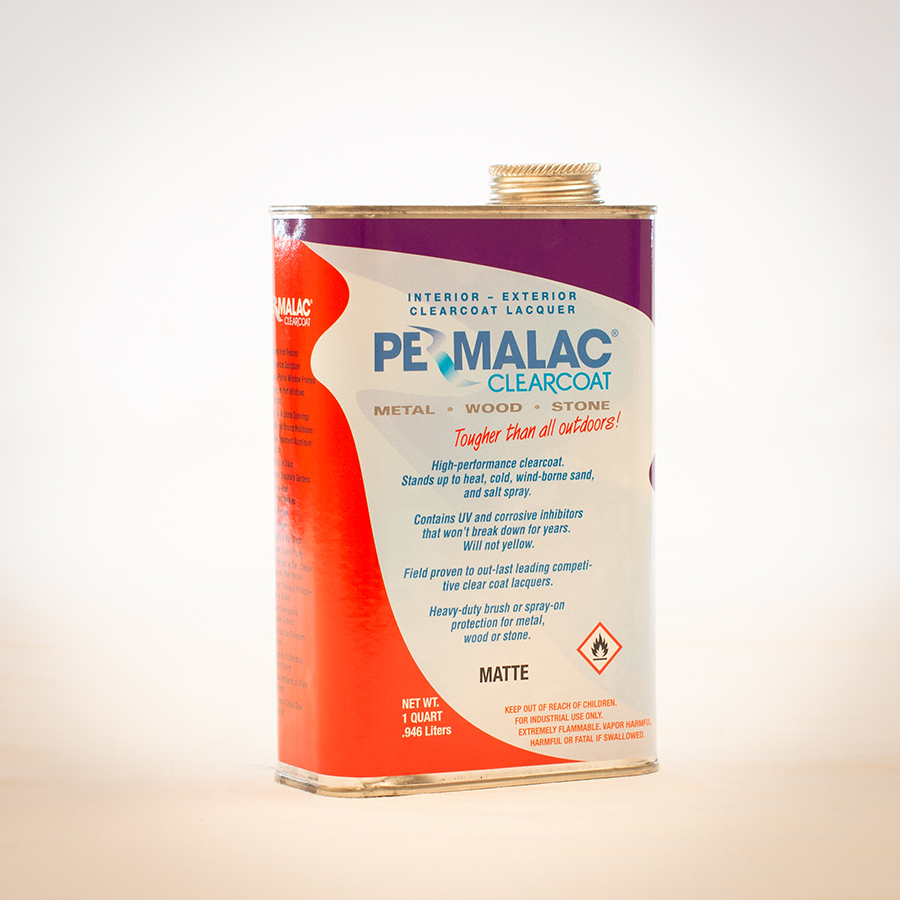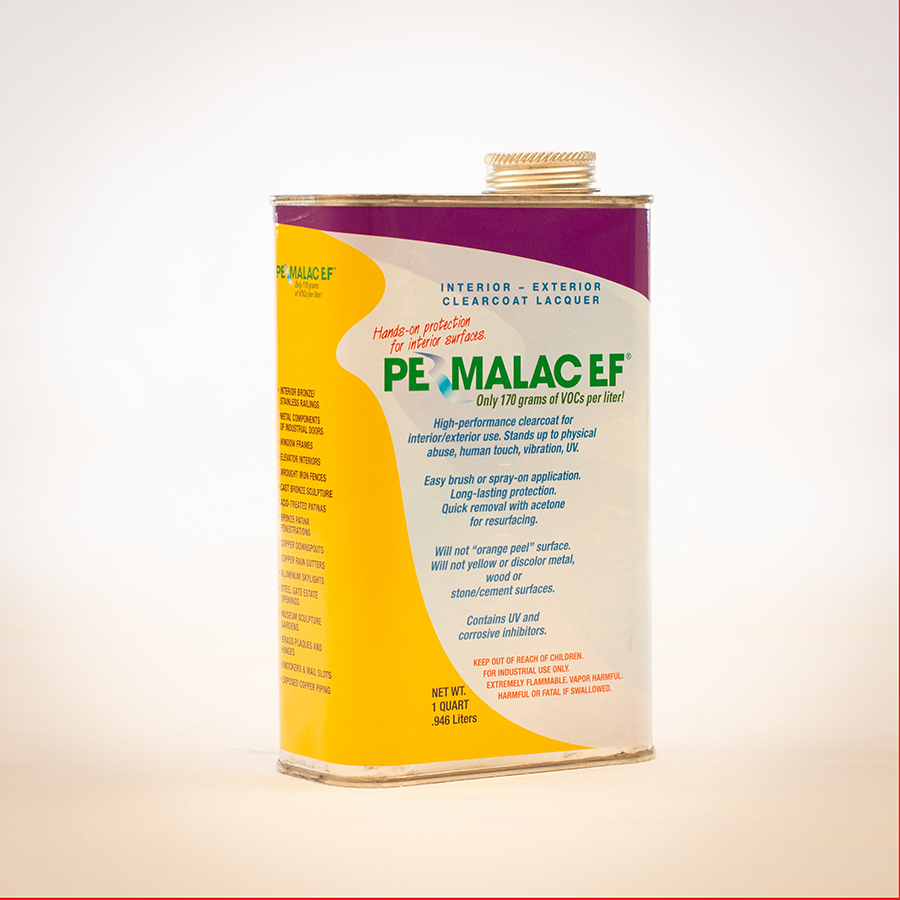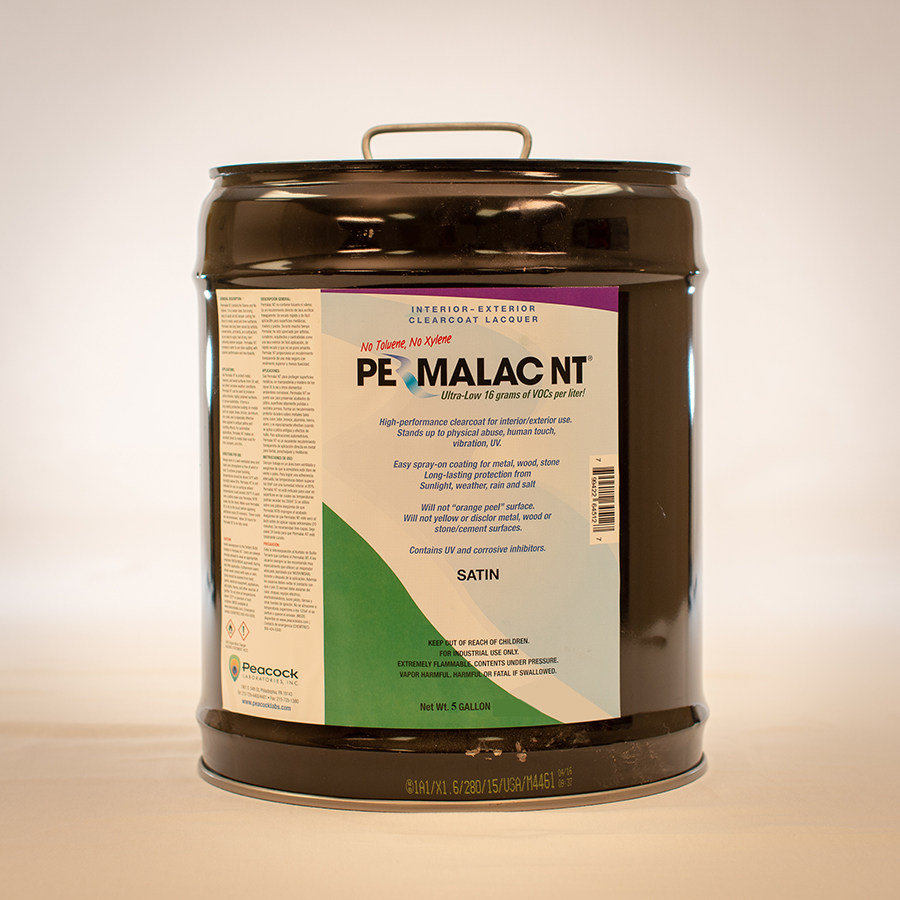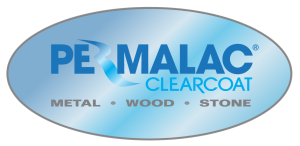


All About Permalac®
WHAT EXACTLY IS PERMALAC?
That’s one of our favorite questions to answer. There are so many definitions floating around on the Internet that it’s best to hear them directly from the source.
Permalac is an air-dry acrylic lacquer and direct-to-substrate protective coating for metal, stone, and wood. It’s primarily designed for protecting surfaces like bronze, brass, copper, steel, silver, and aluminum, and will work indoors and outdoors. Additionally, Permalac has been used in many other applications such as stone surfaces like masonry, stone monuments, terracotta, concrete surfaces such as floors, and even antique wooden chairs. Painted or unpainted wood substrates are easily protected with Permalac as well. We manufacture Permalac in the following lines: Permalac Original (classic bestselling coating), Permalac EF (environmentally friendly and VOC-compliant coating), Permalac NT (“no toluene” and low-VOC coating), and Permalac SR (“scratch-resistant” topcoat).
WHAT MAKES PERMALAC SO GREAT?
Yet another great question! We formulated Permalac to be a superstar in the field of application. It contains state-of-the-art UV and corrosion inhibitors and wide-ranging temperature stabilizers to assure endurance in the harshest conditions ranging from arctic freezing to desert heat, to beachfront salt air to acid rain. It can behave as a sealer (in case you decide to paint over it) or a highly resistant topcoat, protecting from all types of environmental corrosives. On metals, Permalac is flexible and does not separate when the metal is bent. It also protects circuit breakers and other electrical components from molds and mildew, helping to avoid short-circuiting and other disruptive difficulties. Best of all, Permalac’s performance is long-lasting. It can withstand anywhere from 3-5 years of corrosion in outdoor environments OR approximately 8-10 years of wear and tear indoors, all with a single application! This saves you time, money, and effort in the long run. Permalac is a premium product with exceptional performance and durability.
SUGGESTED PREP, APPLICATION, AND CLEANING PROCEDURES
The following instructions apply to all types of Permalac Original, Permalac EF, and Permalac NT.
Determine your application method: This decision should be made based on your experience and skill level, as well as the size and nature of the job. If the Permalac must be applied on location, it might be best to use a brush to avoid overspray. Small parts and jewelry might be best dipped. You should spray a large project for speed and ease of application. Regardless of your application method, your substrate must be clean and moisture-free. We recommend wiping non-porous substrates with acetone or lacquer thinner to degrease and assist in wetting.
Preparation of the substrate: We recommend you first clean your substrate using warm water, soap (dish soap or any basic alcohol-free soap), and a soft cloth if you can visually observe dust, grime, or grease on its surface. Once this is done, follow up by further degreasing the substrate using lacquer thinner or acetone and a clean rag. After you have finished, allow the surface to become fully dry prior to starting the Permalac application.
Spraying Permalac: When spraying Permalac, you may need to thin it first (not required for Permalac NT)*. This can be done with most commercially available lacquer thinners. Peacock Laboratories also manufactures a complete array of thinners to suit varying weather conditions and customer preferences. The mix ratio is four parts Permalac to one part thinner. You may increase this ratio to three parts Permalac to one part thinner if conditions are particularly hot and dry or the substrate is particularly porous. For spraying steel, the mix ratio is one part Permalac to one part thinner for the first coat, then four parts Permalac to one part thinner for the remaining coats. Once the Permalac has been reduced, it can be sprayed.
Be sure to follow all the safety guidelines outlined in the SDS sheet(s). This includes using an NAIC-approved organic solvent respirator and goggles and Permalac in a ventilated area. The recommended spray gun is an HVLP sprayer with a 1.0-1.3 mm tip. Use 20-30 psi and adjust the gun so the material is fully atomized. You also want to avoid large droplets in your spray. When spraying, you want to lay enough coating to make the surface wet, and the droplets flow together. Apply three coats for interior applications OR 4-6 coats for exterior applications in this manner (wood/stone may require 4-8 coats), allowing 0.5-1 hour between coats. You may wish to add anywhere between 2-5% of our #500 retarding thinner to your lacquer mix to combat issues such as solvent pop or hazing because of high humidity or temperature in the surrounding environment. If you see orange peel, allow the Permalac to cure for 1 to 2 hours and then wet sand with 400 grit paper. Use a tack cloth to remove the resulting dust and moisture and apply a final coat of Permalac. When finished, allow 72 hours minimum before packing or putting the item to use. Clean your equipment with acetone, xylene, Permalac Strip, or lacquer thinner.
*Permalac NT usually doesn’t require thinner, though it may be beneficial to use some for the first coat of product application to help “bite” the metal surface. Permalac NT Low Odor Thinner or #770 Low VOC Thinner are recommended. Thinner may also come in handy in conditions of heat or high humidity. Use a 1:1 ratio (lacquer to thinner) for the first coat, followed by a 4:1 ratio for subsequent coats.
Brushing Permalac: Permalac can be brushed on at total concentration. During hot weather, you may wish to thin the Permalac by 15% with a standard thinner or 5% with a retarding thinner to help flow out brush marks. Use a good quality solvent-grade brush, and do not overwork. Apply three coats for interior applications OR 4-6 coats for exterior applications, waiting 0.5-1.5 hours between coats. Allow it to cure for 24 hours minimum (72 hours highly recommended) and clean up with acetone. PERMALAC DOES NOT ROLL ON WELL.
Dipping Permalac: Use a hook or appropriate jig to dip your part into Permalac. Gently shake off any excess droplets. Allow to dry for one hour and repeat. Allow to cure for 24 hours (72 hours highly recommended).
Maintaining/Cleaning Permalac: Wash Permalac-coated substrates with soap, water, and a soft sponge or rag. Do not use abrasive cleaners or scouring pads. Do not use solvents, such as mineral spirits or acetone. Do not use any cleaners with acidic components or any compounds such as ammonia. Scratches can be repaired by cleaning the damaged area with soap and water, thoroughly drying it, and finally reapplying Permalac. Should you need to remove Permalac Original, EF, or NT, it can be stripped with either lacquer thinner or acetone. Surfaces coated with Permalac Original, EF, or NT are NOT OKAY to be cleaned with alcohol-containing cleaners. This will remove the finish.
Reapplying Permalac with time: Permalac usually lasts about 8-10 years on interior applications and approximately 3-5 years on exterior applications. It should still be reapplied to maintain the finish and its protective capabilities. The reapplication window for Permalac is every 3-5 years; as you see, the finish begins to wear down with time. The existing Permalac layer can be cleaned with soap and water solution and then coated on top with more layers of Permalac (as recommended in the first section). Alternatively, you can strip down the Permalac layers on your substrate with acetone or lacquer thinner (soaked on a rag and wiped on, for instance) and then reapply as recommended.
Permalac Do’s
- Do spray Permalac or brush on properly prepared surfaces
- Do ensure that surfaces are thoroughly cleaned and dry before application
- Do apply Permalac directly on prepared surfaces without the need for a primer
- Do expect your Permalac finish to last for years to come. When resurfacing is required, remove with acetone
- Do brush on Permalac if a large area exists and overspray can occur
- Do expect Permalac to be effective against ultra-violet light, alt (and salt air), and acid rain.
- Do spray large surfaces for speed of production if needed
- Do use Permalac on jewelry (dipped is the best outcome but it can be sprayed or brushed)
- Do immediately wash the affected skin to be cleaned with soap and water
- Do wash your eyes out properly should spray or overspray, come in contact with your eyes, and report to an emergency room with eye damage to be treated effectively.
Permalac Don’ts
- Don’t use Permalac without proper ventilation
- Don’t spray in confined spaces where other materials can be affected by overspray.
- Don’t allow large droplets to form when spraying or brushing Permalac
- Don’t apply to materials that are not listed in this guide. (i.e. plastics, certain alloys, others not listed)
- Don’t allow exposed skin to remain in contact with Permalac for an extended period
- Don’t allow spray or overspray to come in contact with eyes
- Don’t roll Permalac on
- Don’t attempt to spray on Permalac at full strength (unless you use a spray can). Follow the thinning instructions provided on the container.
- Don’t use abrasive cleaners or scouring pads. Wash finished surfaces with soap and water only.
We hope this handy guide can be of service for all of your projects both large and small. Should you have any uncertainty or questions regarding the proper application of Permalac and its family of products, feel free to reach our customer service team by clicking here.
If you are interested in purchasing Permalac, please click here.
If you would like to request a sample of Permalac, please click here.
To check out some digital swatches of Permalac, please click here.
